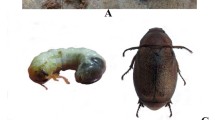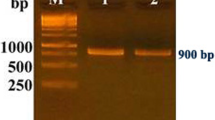Abstract
The root-feeding larvae of white grub Holotrichia serrata F. (Coleoptera: Scarabaeidae) causes serious damage in sugarcane fields in India. Generally, the damage caused by white grubs is in patches, but during severe outbreaks the entire crop in a field may be dried up. Entomopathogenic nematodes (EPN) have proven to be the safest and most effective way of controlling white grubs as both organisms spends a large portion of their life cycle in the soil. To ascertain the diversity of EPN, a survey was conducted in the white grub endemic areas of sugarcane ecosystem in the tropical India. Isolation, molecular identification of EPN and laboratory bioassays was conducted at Nematology Laboratory, ICAR-Sugarcane Breeding Institute, Coimbatore, India. Twenty-four EPN were isolated out of 243 samples, and frequency of occurrence of EPN was 9.87%. Among the 24 positive samples, eight EPN (three Heterorhabditis and five Steinernema) were isolated from dead larvae of naturally infested third instar white grub H. serrata. Out of 24 positive samples, 14 (58.3%) were heterorhabditis and 10 were (41.6%) sterinernematids. Sequencing and characterisation of the internal transcribed spacer region was used to identify all nematode isolates to species level. Out of 14 Heterorhabditis isolates, eight have grouped with H. indica in the indica-group and remaining six were unknown species. Out of 10 Steinernema isolates, two were grouped with Steinernema siamkayai and two isolates grouped close to S. backanense, while the remaining six unknown isolates clustered closely with S. affine, but these isolates form a separate cluster which is genetically different from other group of Steinernema spp. Bioassay studies were conducted under laboratory conditions against first, second and third instar larvae of white grub H. serrata. Among the five H. indica isolates, H. indica (DSM78) recorded maximum mortality of the grubs and low median lethal dose (LD50) value for all the three instars of white grub. Two field trials were conducted during June 2011 to evaluate the efficacy of H. indica (DSM78) against naturally infested white grub H. serrata sugarcane fields. In both the trials, reduction in number of grubs observed in the EPN treated plots compared to the control. The reduction in grub population due to EPN treatment ranged between 43.5 and 77% at field trial I and 30–78% at field trial II. The results of the present study clearly indicated that EPN, H. indica isolate DSM78 was found to be effective and a potential EPN isolate against all the three instars of white grub larvae under laboratory bioassays as well as in the field conditions.





Similar content being viewed by others
References
Anonymous. 2000. Annual report. Coimbatore: Sugarcane Breeding Institute.
Anonymous. 2017. Sugar statistics. Cooperative Sugar 48 (11): 52.
Bedding, R.A., and R.J. Akhurst. 1975. A simple technique for the detection of insect parasitic nematodes in soil. Nematology 21: 109–110.
Bedding, R.A., A.S. Molyneux, and R.J. Akhurst. 1983. Heterorhabditis spp., Neoaplectana spp. and Steinernema kraussei: Interspecific and intraspecific differences in virulence for insects. Experimental Parasitology 55: 249–257.
Bharathi, S., and P.B. Mohite. 2015. Biocontrol potential of entomopathogenic nematodes Heterorhabditis and Steinernema against second instar grub of white grub, Leucopholis lepidophora (Blanchard). International Journal of Science and Research, 4(10): 908–909. ISSN (Online): 2319-7064.
David, H., and K. Ananthanarayana. 1986. White grubs. In Sugarcane entomology in India, ed. H. David, S. Easwaramoorthy, and R. Jayanthi, 193–208. Coimbatore: Sugarcane Breeding Institute.
David, H., and N.K. Kurup. 1988. Techniques for mass production of Sturmiopsis inferens Tns. In Biocontrol technology for sugarcane pest management, ed. H. David and S. Easwaramoorthy, 87–92. Coimbatore: Sugarcane Breeding Institute.
Easwaramoorthy, S., and G. Santhalakshmi. 1988. Microbial control of sugarcane pests. In Biocontrol technique for sugarcane pests management, ed. H. David and S. Easwaramoorthy, 272–292. Coimbatore: Sugarcane Breeding Institute.
Ehlers, R.U. 2001. Mass production of entomopathogenic nematodes for plant protection. Applied Microbiology and Biotechnology 56: 623–633.
Ganguly, S. 2003. Taxonomy of entomopathogenic nematodes and work done in India. In Current status of research on entomopathogenic nematodes in India, ed. S.S. Hussaini, R.J. Rabindra, and M. Nagesh, 69–108. Bangalore: PDBC, ICAR.
Ganguly, S. 2006. Recent taxonomic status of entomopathogenic nematodes: A review. Indian Journal of Nematology 36: 158–176.
Ganguly, S., S. Kumar, and K.S. Rathour. 2010. Availability of biopesticidal nematodes to suit different agro-climatic region of India for commercialisation. Indian Journal of Nematology 40: 261–264.
Ganguly, S., and L.K. Singh. 2000. Steinernema thermophilum sp. n. (Rhabditida: Steinernematidae) from India. International Journal of Nematology 10: 183–191.
Guo, W., X. Yan, G. Zhao, and J. Chen. 2015. Efficacy of entomopathogenic Steinernema and Heterorhabditis nematodes against Holotrichia oblita. Journal of Pest Science 88: 359–368.
Gupta, K.M. 1973. Neem leaves attract white grub beetles. Indian Journal of Entomology 35: 276.
Hominick, W. 2002. Biogeography. In Entomopathogenic nematology, ed. R. Gaugler, 115–143. Wallinford: CABI Publishing.
Hominick, W.M., A.P. Reid, D.A. Bohan, and B.R. Briscoe. 1996. Entomopathogenic nematodes: Biodiversity, geographical distribution and the convention on biological diversity. Biocontrol Science and Technology 6: 317–331.
Hussaini, S.S., M.A. Ansari, W. Ahmad, and S.A. Subbotin. 2001. Identification of some Indian populations of Steinernema species (Nematoda) by RFLP analysis of the ITS region of rDNA. International Journal of Nematology 11: 73–76.
Josephrajkumar, A., and C.V. Sivakumar. 1997. A survey for entomopathogenic nematodes in Kanyakumari district, Tamil Nadu, India. Indian Journal of Entomology 59: 45–50.
Joyce, S.A., A. Reid, F. Driver, and J. Curran. 1994. Application of polymerase chain reaction (PCR) methods to the identification of entomopathogenic nematodes. In COST 812 Biotechnology: Genetics of entomopathogenic nematode-bacterium complexes. Proceedings of symposium and workshop, ed. A.M. Burnell, R.-U. Ehlers, and J.-P. Masson, 178–187. St Patrick’s College, Maynooth, County Kildare: European Commission, DGXII, Luxembourg.
Karunakar, G. 1990. Studies on entomophilic nematodes on sugarcane. M.Sc. thesis submitted to Tamilnadu Agricultural University, Coimbatore, 180.
Karunakar, G., S. Easwaramoorthy, and H. David. 2000. Host parasite interaction between two species of white grubs infesting sugarcane and two species of entomopathogenic nematodes. Sugar Tech 2: 12–16.
Kaya, H.K., M.M. Aguillera, A. Alumai, H.Y. Choo, M. de la Torre, A. Fodor, S. Ganguly, S. Hazir, T. Lakatos, and A. Pye. 2006. Status of entomopathogenic nematodes and their symbiotic bacteria from selected countries or regions of the world. Biological Control 38: 134–155.
Kaya, H.K., and S.P. Stock. 1997. Techniques in insect nematology. In Manual of techniques in insect pathology, ed. L.A. Lacey, 281–324. San Diego: Academic Press.
Khan, M.R., and Z. Haque. 2010. Occurrence of entomopathogenic nematodes in Districts of Western Uttar Pradesh, India. Indian Journal of Nematology 40: 264–266.
Koppenhofer, A.M., and E.M. Fuzy. 2004. Effect of white grub developmental stage on susceptibility to entomopathogenic nematodes. Journal of Economic Entomology 97: 1842–1849.
Malan, A.P., R. Knoetze, and D. Moore. 2011. Isolation and identification of entomopathogenic nematodes from citrus orchards in South Africa and their biocontrol potential against false codling moth. Journal of Invertebrate Pathology 108: 115–125.
Malan, A.P., K.B. Nguyen, J.Y. De Waal, and L. Tiedt. 2008. Heterorhabditis safricana n. sp. (Rhabditida: Heterorhabditidae), a new entomopathogenic nematode from South Africa. Nematology 10: 381–396.
Mehta, U.K. 1998. Evaluation of entomopathogenic nematodes for the biological control of whitegrub in sugarcane. Abstracts of National symposium on ‘Rational approaches in Nematode Management for Sustainable Agriculture’, GAU, Anand, 19.
Mohan, S. 2013. White grub management by H. indica infected Galleria cadavers. IARI News 29 (1): 2.
Morris, O.N., V. Converse, and J. Harding. 1990. Virulence of entomopathogenic nematode-bacteria complexes for larvae of noctuids, a geometrid and a pyralid. Canadian Entomologist 122: 309–320.
Parihar, A., A.U. Siddiqui, Y.S. Yadav, and B. Ram. 2003. Occurrence of entomopathogenic nematodes in Rajasthan. Indian Journal of Nematology 65: 190–193.
Poinar Jr., G.O., G.K. Karunakar, and H. David. 1992. Heterorhabditis indicus n.sp. (Rhabditida: Nematoda) from India: Separation of Heterorhabditis spp. by infective juveniles. Fundamental and Applied Nematology 15: 467–472.
Potter, D.A., A.J. Powell, P.G. Spicer, and D.W. Williams. 1996. Cultural practices affect root feeding white grubs (Coleoptera: Scarabaeidae) in turfgrass. Journal of Economic Entomology 89: 156–164.
Raodeo, A.K., S.V. Deshpande, A.D. Deshpande, S.N. Puri, and G.G. Biiapate. 1976. A large scale campaign for the control of white grubs (Holotrichia serrata F.) in Maharashtra State. PANS 22: 223–228.
Sankaranarayanan, C., B. Singaravelu, and M. Shunmugasundaram. 2011. Effect of temperature on pathogenecity of Heterorhabditis and Steinernema spp. against white grub Holotrichia serrata F. (Coleoptera: Scarabaeidae). Abstract of paper presented in the national symposium on “Nematodes: A challenge under changing climate and agriculture practices” held at Thiruvanthapuram from 16th to 18th November 2011, 122. (Contribution No. 24/11-12/SBI).
Sankaranarayanan, C., and B. Singaravelu. 2012. Effect of entomopathogenic nematodes and entomopathogenic fungi against white grub Holotrichia serrata F. (Coleoptera: Scarabaeidae). Abstract of paper presented in the International Symposium on New Paradigms in Sugarcane Research (ISNPSR-2012) on 15–18, October, 2012 at Coimbatore, 267.
Sankaranarayanan, C., and B. Singaravelu 2013. Isolation of entomopathogenic nematodes from white grub endemic areas of sugarcane and its biocontrol efficacy against white grub Holotrichia serrata under field conditions. Abstracts of paper presented in National Nematology symposium on “Nematode: A Friend and Foe of Agri-Horticultural Crops” held at Solan from 21st to 23rd November 2013, 145.
Seenivasan, N., S. Prabhu, S. Makesh, and M. Sivakumar. 2012. Natural occurrence of entomopathogenic nematode species (Rhabditida: Steinernematidae and Heterorhabditidae) in cotton fields of Tamil Nadu, India. Journal of Natural History 46: 2829–2843.
SPSS (Statistical Package for the Social Sciences). 2007. Statistical product and service solution, system user’s guide.
Srikanth J., and B. Singaravelu. 2011. White grub (Holotrichia serrata) as pest of sugarcane and its management. Technical Bulletin No 197, 1–8. Coimbatore: Sugarcane Breeding Institute.
Tamura, K., G. Stecher, D. Peterson, A. Filipski, and S. Kumar. 2013. MEGA6: Molecular evolutionary genetics analysis version 6.0. Molecular Biology and Evolution 30: 2725–2729.
Varadarasan, S., T. Sooravan, S.S. Chandrasekar, M.A. Ali, and J. Thomas. 2006. A survey for entomopathogenic nematodes in cardamom growing areas of Kerala and Tamil Nadu. Journal of Plantation Crops 34: 398–400.
Veeresh, G.K. 1983. White grubs. In Applied soil biology and ecology, ed. G.K. Veeresh and D. Rajagopal. New Delhi: Oxford and IBH Publishing Co. Pvt. Ltd.
Villani, M.G., and R.J. Wright. 1988. Entomogenous nematodes as biological control agents of European chafer and Japanese beetle (Coleoptera: Scarabaeidae) larvae infesting turf grass. Journal of Economic Entomology 81: 484–487.
Wang, Y., J.F. Campbell, and R. Gaugler. 1995. Infection of entomopathogenic nematodes Steinernema glaseri and Heterorhabditis bacteriophora against Popillia japonica (Coleoptera: Scarabaeidae) larvae. Journal Invertebrate Patholology 66: 178–184.
Woodring, J.L., and H.K. Kaya. 1988. Steinernematid and Heterorhabditid nematodes. In A handbook of biology and techniques, 30. Southern Cooperative Series Bulletin No. 331. Fayetteville, Arkansas: Arkansas Agricultural Experiment Station.
Acknowledgements
The authors would like to express their sincere gratitude to Dr. Bakshi Ram, Director, ICAR-Sugarcane Breeding Institute, Coimbatore, for his valuable encouragement and facilities provided to conduct this study. The authors thank Scientists, Dr. C. Appunu and Dr. G. S. Suresha, ICAR-Sugarcane Breeding Institute, Coimbatore, for their help in the phylogenetic analysis. Thanks are also due to M/s. Bannari Amman Sugars Limited, Sathyamangalam and M/s. Dharmapuri Co-operative sugar Mill, Palacode, for providing the logistic support to carry out the field trails.
Author information
Authors and Affiliations
Corresponding author
Ethics declarations
Conflict of interest
The authors declare that they have no conflict of interest.
Rights and permissions
About this article
Cite this article
Sankaranarayanan, C., Singaravelu, B. & Rajeshkumar, M. Entomopathogenic Nematodes (EPN): Diversity in Indian Tropical Sugarcane Ecosystem and Its Biocontrol Potential Against White Grub Holotrichia serrata F. on Sugarcane. Sugar Tech 21, 371–382 (2019). https://doi.org/10.1007/s12355-018-0628-9
Received:
Accepted:
Published:
Issue Date:
DOI: https://doi.org/10.1007/s12355-018-0628-9




